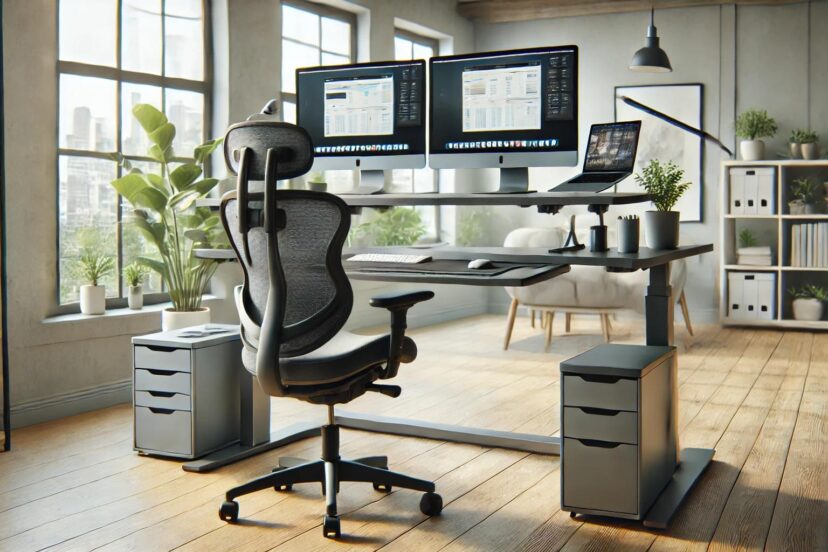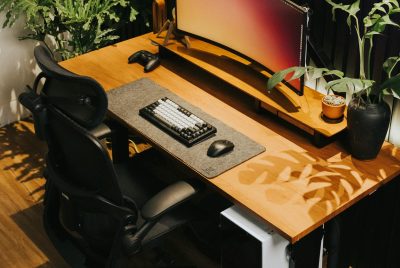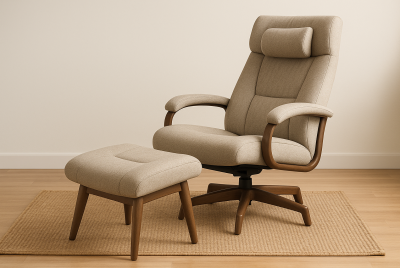Ergonomical: The Art of Comfort and Efficiency
We may earn a commission for purchases made using our links. Please see our disclosure to learn more.
Hey there workaholic folks! Have you ever thought about how comfortable (or should I say, uncomfortable) your workspace is? Not yet? Well, maybe you’ve been working for years now and are so focused on your goals that you forgot to reflect on your well-being. I can’t blame you, sometimes we just get too busy that we ignore the body pain we feel after a long, tiring (and stressful) day at work. But hey, let’s step back a little bit and discover the world of an ergonomical workspace where true comfort lies. Let’s dive right in!
What Does Ergonomical Really Mean?
So, what’s this so-called ‘ergonomical’? Let’s make this simple shall we: Ergonomical or ergonomics is all about designing things, spaces, or tools that ‘fit us’ (not the other way around) so we can move smoothly and efficiently. Basically, allowing us to make adjustments so it fits our body’s natural form and curvature. Imagine your chair and desk all adjusted (seat height, backrests, armrests) so you won’t make awkward movements and complain of body aches after sitting on it for hours. It’s really about making you feel comfortable while working.

Why Is Being Ergonomical Important?
If you care about your health, then you should consider ergonomical things. You see… I’ve been working for years and trust me, I didn’t care about how my workstation looked before. The only thing that matters to me is that I have a desk, a sturdy chair, and some office tools I need. Not until it took a toll on my health. I noticed that my back and wrist pain started to get worse over time and every mouse click hurt. Even drinking ibuprofen won’t work! So, I went to the doctor and he advised me to have a healthy lifestyle and get a chair with good lumbar support. That’s how I started with ergonomics. Being ergonomical is the key to staying healthy, pain-free, and yes, even more productive (cause who can work properly with such nasty pain, right?).
Research shows that adopting ergonomical interventions such as sit-stand desks and ergonomic training significantly reduces musculoskeletal discomfort and enhances productivity. Studies in both office and healthcare environments demonstrated that workers experienced less neck and back pain, improved job satisfaction, and reduced injury-related costs when ergonomic improvements were implemented. These findings highlight the importance of ergonomics for both health and economic benefits in the workplace. Read more in these detailed studies from SpringerLink and PLOS ONE.
The Relationship Between Ergonomics and Health
As I said, ergonomics is really important if you want to stay healthy and away from discomfort. Imagine working for 8 hours sitting on a sturdy but wooden chair. What do you think will happen? After 2 hours you will start slouching. After another 2 hours, you’ll start complaining your lower back hurts. See what I mean? You can’t be productive and happy in that case. So, switching to a more comfortable and adjustable chair can change the game. Not only will it make you comfortable but it also minimizes the risk of injury. After all, nobody likes a creaky back.
The Role of Ergonomics in the Workplace
Alright, let’s talk about the place where we spend a huge chunk of our time from Mondays to Fridays—the workplace. Whether you’re in a corporate office or working from your kitchen counter, ergonomics plays a crucial role in how you feel and perform. Your monitor, keyboard, and mouse should not be too close, or too far from you. Meaning, it should be within reach so you don’t have to stretch just to type and scroll away. This small tweak has a big impact I swear. Businesses that embrace ergonomics see happier, healthier employees—and who wouldn’t want to boost morale and productivity with just a few adjustments?
Ergonomics for the Remote Worker
Working from home? Same here! Even for people like us, being ergonomical is still important, not just in the office. I think the stakes are even higher! Why? If you’re like me and your mini office is inside your room, it’s tempting to sink into your bed with your laptop. Common’ don’t lie to me now! But, our spine will scream for help because of that. Investing in a proper ergonomic chair (doesn’t have to be too expensive), a decent desk and an adjustable monitor can transform your home office into a safe environment. Think of it as designing a workspace that works *with* you, not against you. And let’s be honest, when you’re comfortable, your workday just flies by.
Key Ergonomic Elements to Consider
By now, you’re probably wondering what exactly makes a workspace ergonomical. Here’s a cheat sheet of the essentials:
1. Chair – An ergonomic chair should feel like it was designed for your body. It supports your lower back, encourages good posture, and adjusts to your needs.
2. Desk – A desk that allows your arms to rest comfortably while keeping your wrists neutral is a game changer.
3. Monitor – Place it at eye level to avoid straining your neck. It’s simple, but it works.
4. Keyboard and Mouse – These should feel natural, promoting a neutral wrist position to ward off those dreaded repetitive strain injuries.
Top Ergonomic Products
Feeling ready to make the leap? Here are some ergonomic products worth checking out:
– Ergonomic Chairs: Herman Miller Aeron, Steelcase Leap, Secretlab Titan Evo 2022. These chairs are designed with lumbar support, adjustable features, and materials that breathe.
– Standing Desks: FlexiSpot E7, Uplift V2, Vari Electric Standing Desk. These desks allow you to switch between sitting and standing with ease.
– Ergonomic Keyboards: Microsoft Sculpt, Logitech Ergo K860, Kinesis Advantage2. Split-key designs and wrist support are your friends here.
– Ergonomic Mouse: Logitech MX Vertical, Anker Vertical, Razer DeathAdder V2. Vertical designs with easy-to-reach buttons can save your wrists.
– Footrests: Everlasting Comfort, ErgoFoam Adjustable Footrest. It’s all about posture and circulation, even for your feet.
The Impact of Poor Ergonomics
What if you just… ignore ergonomics? Then be ready for an appointment physiotherapist. No kidding! That’s what has happened to me before because I don’t care about ergonomics in the workplace. Really, without ergonomics, you’re setting yourself up for a cascade of issues, from carpal tunnel to chronic back pain. It’s uncomfortable, frustrating, and definitely not good for the long haul. Not only does it drag down your health, but it also affects your mental well-being and performance. So if I were you, listen to your body and try to improve your workplace. Hey, it doesn’t have to be expensive! You can DIY and save until you can buy an ergonomic chair and desk.
How to Create an Ergonomical Workspace
Ready to make your space a haven of comfort? Here’s how to do it:
1. Adjust Your Chair – Keep your feet flat on the ground, and your knees at a 90-degree angle. Your back should feel fully supported.
2. Monitor Placement – Place your screen so the top is at or just below eye level. Keep it about an arm’s length away.
3. Keyboard and Mouse Setup – Keep them close to the edge of your desk, allowing your wrists to stay neutral.
4. Lighting – Good lighting reduces eye strain, so avoid harsh glares by placing your light source to the side of your monitor.
5. Take Breaks – Even the best setup can’t save you from stiffness if you don’t move! Stretch and reset regularly.
Final Thoughts
Having an ergonomical workstation can make a huge difference in comfort and efficiency. In the hectic world we live in, it’s a must to look over our own wellbeing. By making a few tweaks to your workspace and healthy lifestyle, you can protect your health and say goodbye to back, neck, and wrist pains. Whether you’re working at home or in the office, being ergonomical is the key to being comfortable and working efficiently. Transform your work environment today!
FAQs
1. What is ergonomics?
Ergonomics is about designing products to fit the people who use them for improved comfort, and efficiency.
2. Why is ergonomics important in the workplace?
Ergonomics helps create a more supportive workplace and prevent physical injuries.
3. How can I make my desk setup more ergonomic?
Start with adjusting your chair so your feet are flat on the floor, raise your monitor to eye level, and ensure your keyboard and mouse promote a neutral wrist position.
4. Do I need expensive equipment to be ergonomic?
Of course not! Sure, ergonomic furniture can be a big investment, but simple changes like better posture, stacking books under your monitor, or taking regular breaks can change the game.
5. Can ergonomics improve my mental health?
Yes! A comfortable body means less physical stress. Meaning, no more pain so you can focus better during the day.




